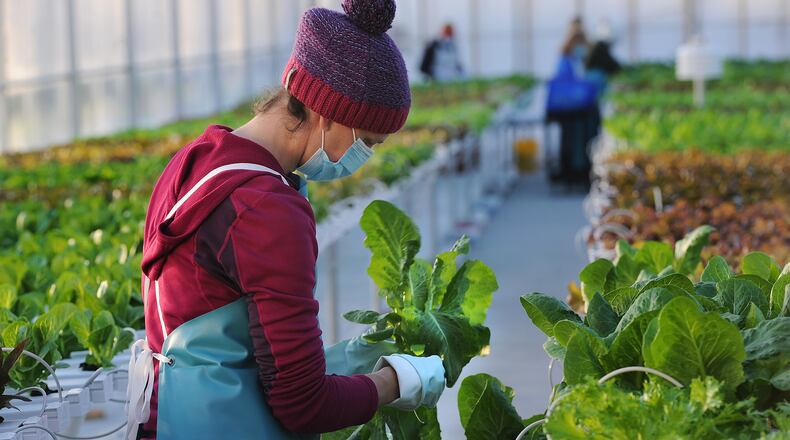“If we were to compare need for food assistance to 2020, especially during the spring of 2020 and during the lockdown at the beginning of the pandemic, at that time we were seeing pretty unprecedented numbers in terms of need,” Tappel said.
What’s occurred during 2021, she said, is stabilization.
The Foodbank makes it drive-thru distribution available three days a week, twice a week for anyone and one day for seniors, Tappel said. In spring 2020, the drive-thru was seeing as many 750 families during a two-hour distribution. This year saw those numbers slow to between 250 to 300 families, slightly more than what it experienced prior to the pandemic.
That’s something Tappel attributes to being part of a community hit by not only the pandemic, but also a tornado in 2019.
“Recovery for those kind of events takes time, so having the pandemic happen shortly after that meant that we had some areas in our community that were hit pretty hard and have needed support through this time,” she said. “Recovery for these types of things will take seven to 10 years.”
It helps that the area has “an incredibly supportive donor base,” she said.
“With the tornadoes and the pandemic in these last three years, we have seen a very generous outpour of support,” Tappel said. “It’s helped us to increase our operations to better meet the needs in our community.
That’s allowed the Foodbank to ramp up its programs, including adding on two mobile food pantries into its monthly location to ensure their reaching all areas experiencing increased need.
“Since the pandemic, I think there’s a greater understanding of how food security impacts communities,” Tappel said. “It doesn’t always look the same. It impacts people differently, and I think that in this time when a lot of people in our community are facing hardship, it doesn’t always appear on the surface.”
The Dayton Foundation, the region’s oldest and largest community foundation, saw “choppiness” across the nonprofit landscape, but in general, many nonprofits to which it contributes did “very, very well financially,” according to Michael Parks, the foundation’s president.
“There was this huge influx of public funding from the (federal government), state, counties and cities through the CARES Act and other commitments of public dollars,” he said. “The nonprofit sector’s never seen anything like it and for many groups, that was an absolute lifesaver and allowed them to financially come through very strong.”
That was coupled with an “unbelievable” outpouring of private philanthropy, one that only saw signs of tapering off as the new fiscal year arrived this past summer, Parks said.
But doing better financially doesn’t mean all nonprofits were able to provide all the programs and services they had in the past, which means they weren’t able to have the reach and impact they normally would, he said.
Michelle Lovely, the foundation’s vice president of development and donor services, said nonprofits had to figure out how to keep their donors engaged through a series of different tactics, including online auctions, fundraisers and other digital-based offerings.
While services were “absolutely disrupted,” there was also a group of nonprofits that stepped up and were the busiest they have ever been because of the services they provided to those who were impacted by the pandemic, Parks said.
Donations to the Dayton Foundation’s COVID-19 Response Fund wrapped up this summer with more than $2 million contributed in the course of a year, he said.
Parks said nonprofits that were dependent on volunteers saw additional struggles, including volunteers that were not necessarily always willing and able to participate at the same level they did pre-pandemic.
However, Parks said individual donors to Dayton Foundation “have never been as generous as they have been in the past year.”
“Collectively, there’s now over 4,000 individuals, families and organizations that have established funds at the foundation, the most in our history,” he said. “Those 4,000 funds represent over $800 million of charitable good, also the highest in our history.”
In 2021, $85 million of new charitable contributions flowed into foundation funds, the largest amount ever in its 100-year history, he said.
The community’s generosity this year allowed the Dayton Foundation to issue to organizations across the region and worldwide approximately 20,000 grants, the most it has ever granted.
Lovely said awareness of the foundation’s 100th anniversary likely spurred additional donations.
“There’s been a lot more understanding this past year of what we do and how we do it versus maybe in past years,” she said.
Tom Maultsby, president and CEO of the United Way of the Greater Dayton Area, said 2021 was tough for the organization and for all nonprofits.
“COVID has something to do with it, but the primary reason it’s been tough for us is because of the impact on businesses,” Maultsby said. “Employees working remotely, many employees being furloughed or laid off or not coming back to work, has had an impact on some of the campaigns that we’ve run. When individuals are not certain about their future, obviously, they make different decisions about giving and philanthropy.”
In addition, the level of need for services, especially for things like rental assistance and food, has increased.
What has helped be a gap-filler is that many of the organizations that support the United Way through their campaign have stepped up, he said.
“They have made an effort to hold their employee giving and their corporate giving at least at levels that it was pre-pandemic,” Maultsby said.
While donation levels are below normal, they are “not catastrophic,” he said. But instead of relying entirely on donations, the United Way of the Greater Dayton Area has been focusing more on grants, “not just because of COVID, but as a strategy because they are available,” Maultsby said.
“It’s a really good way to help us to grow the amount of support for the needs that we have,” he said.
About the Author

